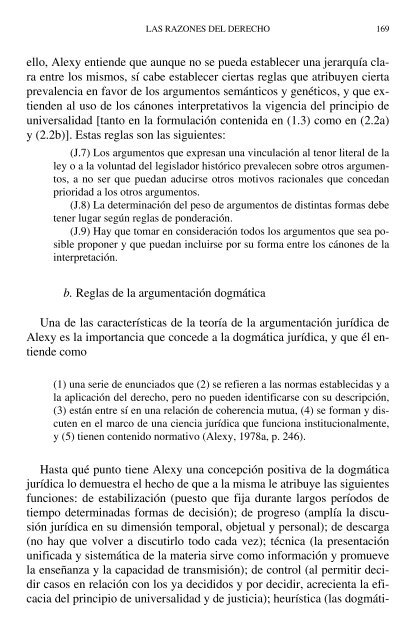LAS RAZONES DEL DERECHO Teo rías de la ar gu men ta ción ju rí di ca
Create successful ePaper yourself
Turn your PDF publications into a flip-book with our unique Google optimized e-Paper software.
<strong>LAS</strong> <strong>RAZONES</strong> <strong>DEL</strong> <strong>DERECHO</strong> 169<br />
ello, Alexy entien<strong>de</strong> que aunque no se pueda es<strong>ta</strong>blecer una jer<strong>ar</strong>quía c<strong>la</strong>ra<br />
entre los mismos, sí <strong>ca</strong>be es<strong>ta</strong>blecer cier<strong>ta</strong>s reg<strong>la</strong>s que atribuyen cier<strong>ta</strong><br />
prevalencia en favor <strong>de</strong> los <strong>ar</strong><strong>gu</strong><strong>men</strong>tos semánticos y genéticos, y que extien<strong>de</strong>n<br />
al uso <strong>de</strong> los cánones interpre<strong>ta</strong>tivos <strong>la</strong> vigencia <strong>de</strong>l principio <strong>de</strong><br />
universalidad [<strong>ta</strong>nto en <strong>la</strong> formu<strong>la</strong><strong>ción</strong> contenida en (1.3) como en (2.2a)<br />
y (2.2b)]. Es<strong>ta</strong>s reg<strong>la</strong>s son <strong>la</strong>s si<strong>gu</strong>ientes:<br />
(J.7) Los <strong>ar</strong><strong>gu</strong><strong>men</strong>tos que expresan una vincu<strong>la</strong><strong>ción</strong> al tenor literal <strong>de</strong> <strong>la</strong><br />
ley o a <strong>la</strong> volun<strong>ta</strong>d <strong>de</strong>l legis<strong>la</strong>dor histórico prevalecen sobre otros <strong>ar</strong><strong>gu</strong><strong>men</strong>tos,<br />
a no ser que puedan aducirse otros motivos racionales que concedan<br />
prioridad a los otros <strong>ar</strong><strong>gu</strong><strong>men</strong>tos.<br />
(J.8) La <strong>de</strong>termina<strong>ción</strong> <strong>de</strong>l peso <strong>de</strong> <strong>ar</strong><strong>gu</strong><strong>men</strong>tos <strong>de</strong> <strong>di</strong>stin<strong>ta</strong>s formas <strong>de</strong>be<br />
tener lug<strong>ar</strong> según reg<strong>la</strong>s <strong>de</strong> pon<strong>de</strong>ra<strong>ción</strong>.<br />
(J.9) Hay que tom<strong>ar</strong> en consi<strong>de</strong>ra<strong>ción</strong> todos los <strong>ar</strong><strong>gu</strong><strong>men</strong>tos que sea posible<br />
proponer y que puedan incluirse por su forma entre los cánones <strong>de</strong> <strong>la</strong><br />
interpre<strong>ta</strong><strong>ción</strong>.<br />
b. Reg<strong>la</strong>s <strong>de</strong> <strong>la</strong> <strong>ar</strong><strong>gu</strong><strong>men</strong><strong>ta</strong><strong>ción</strong> dogmáti<strong>ca</strong><br />
Una <strong>de</strong> <strong>la</strong>s c<strong>ar</strong>acte<strong>rí</strong>sti<strong>ca</strong>s <strong>de</strong> <strong>la</strong> teo<strong>rí</strong>a <strong>de</strong> <strong>la</strong> <strong>ar</strong><strong>gu</strong><strong>men</strong><strong>ta</strong><strong>ción</strong> <strong>ju</strong><strong>rí</strong><strong>di</strong><strong>ca</strong> <strong>de</strong><br />
Alexy es <strong>la</strong> impor<strong>ta</strong>ncia que conce<strong>de</strong> a <strong>la</strong> dogmáti<strong>ca</strong> <strong>ju</strong><strong>rí</strong><strong>di</strong><strong>ca</strong>, y que él entien<strong>de</strong><br />
como<br />
(1) una serie <strong>de</strong> enunciados que (2) se refieren a <strong>la</strong>s normas es<strong>ta</strong>blecidas y a<br />
<strong>la</strong> apli<strong>ca</strong><strong>ción</strong> <strong>de</strong>l <strong>de</strong>recho, pero no pue<strong>de</strong>n i<strong>de</strong>ntific<strong>ar</strong>se con su <strong>de</strong>scrip<strong>ción</strong>,<br />
(3) están entre sí en una re<strong>la</strong><strong>ción</strong> <strong>de</strong> coherencia mutua, (4) se forman y <strong>di</strong>scuten<br />
en el m<strong>ar</strong>co <strong>de</strong> una ciencia <strong>ju</strong><strong>rí</strong><strong>di</strong><strong>ca</strong> que funciona institucional<strong>men</strong>te,<br />
y (5) tienen contenido normativo (Alexy, 1978a, p. 246).<br />
Has<strong>ta</strong> qué punto tiene Alexy una concep<strong>ción</strong> positiva <strong>de</strong> <strong>la</strong> dogmáti<strong>ca</strong><br />
<strong>ju</strong><strong>rí</strong><strong>di</strong><strong>ca</strong> lo <strong>de</strong>muestra el hecho <strong>de</strong> que a <strong>la</strong> misma le atribuye <strong>la</strong>s si<strong>gu</strong>ientes<br />
funciones: <strong>de</strong> es<strong>ta</strong>biliza<strong>ción</strong> (puesto que fija durante <strong>la</strong>rgos pe<strong>rí</strong>odos <strong>de</strong><br />
tiempo <strong>de</strong>terminadas formas <strong>de</strong> <strong>de</strong>cisión); <strong>de</strong> progreso (amplía <strong>la</strong> <strong>di</strong>scusión<br />
<strong>ju</strong><strong>rí</strong><strong>di</strong><strong>ca</strong> en su <strong>di</strong><strong>men</strong>sión temporal, objetual y personal); <strong>de</strong> <strong>de</strong>sc<strong>ar</strong>ga<br />
(no hay que volver a <strong>di</strong>scutirlo todo <strong>ca</strong>da vez); técni<strong>ca</strong> (<strong>la</strong> presen<strong>ta</strong><strong>ción</strong><br />
unifi<strong>ca</strong>da y sistemáti<strong>ca</strong> <strong>de</strong> <strong>la</strong> materia sirve como informa<strong>ción</strong> y promueve<br />
<strong>la</strong> enseñanza y <strong>la</strong> <strong>ca</strong>pacidad <strong>de</strong> transmisión); <strong>de</strong> control (al permitir <strong>de</strong>ci<strong>di</strong>r<br />
<strong>ca</strong>sos en re<strong>la</strong><strong>ción</strong> con los ya <strong>de</strong>ci<strong>di</strong>dos y por <strong>de</strong>ci<strong>di</strong>r, acrecien<strong>ta</strong> <strong>la</strong> efi<strong>ca</strong>cia<br />
<strong>de</strong>l principio <strong>de</strong> universalidad y <strong>de</strong> <strong>ju</strong>sticia); heu<strong>rí</strong>sti<strong>ca</strong> (<strong>la</strong>s dogmáti-



